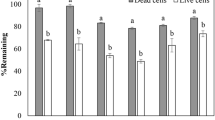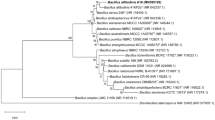Abstract
Bromoxynil octanoate (BOO), the most widespread herbicide applied to maize, is potentially toxic to both animals and humans. In this article, a highly effective BOO-degrading bacterial strain, XB2, was isolated from the soil of a herbicide factory. The strain was identified as an Acinetobacter sp. based on its 16S rRNA gene sequence analysis, morphological, physiological, and biochemical properties. This strain could use BOO as its sole carbon source and could degrade 100 mg l−1 BOO to non-detectable levels in 72 h (h). The optimal pH and temperature for strain XB2’s growth and degradation of BOO in MSM are 7.0 and 30°C, respectively. We propose the following pathway of BOO degradation by strain XB2: the first step is the scission of the ester bond to form bromoxynil, bromoxynil then transformed to 3,5-dibromo-4-hydroxybenzoic acid due to the hydrolysis of nitriles, and debromination finally results in the formation of 3-bromo-4-hydroxybenzoic acid. Inoculating BOO-treated soil samples with strain XB2 resulted in a higher rate of BOO degradation than in non-inoculated soil, regardless of whether the soil had previously been sterilized.








Similar content being viewed by others
References
Scheunert I, Gunthner A, Rosenbrock P (2001) Long-term fate and effects of the herbicide bromoxynil in soil cropped with maize. www-naweb.iaea.org
Ma J, Wang P, Chen J, Sun Y, Che J (2007) Differrential response of green algal species Pseudokirchneriella subcapitata, Scenedesmus quadricauda, Scenedesmus obliquus, Chlorella vulgaris and Chlorella pyrenoidosa to six pesticides. Polish J Environ Stud 16:847–851
Brown DF, McDonough LM, McCool DK, Papendick RI (1984) High-performance liquid chromatographic determination of bromoxynil octanoate and metribuzin in runoff water from wheat fields. J Agric Food Chem 32:195–200
Buckland JL, Collins RF, Pullin EM (1973) Metabolism of bromoxynil octanoate in growing wheat. Pest Sci 4:149–162
Holt JG, Krieg NR, Sneath PH, Staley JT, Williams ST (2004) Bergey’s manual of determinative bacteriology, 9th edn. Williams & Wilkins, Baltimore
Li R, Zheng JW, Wang R, Song Y, Chen QM, Yang XJ, Li SP, Jiang JD (2010) Biochemical degradation pathway of dimethoate by Paracoccus sp. Lgjj-3 isolated from treatment wastewater. Int Biodeter Biodegr 1:21–57
Thompson JD, Gibson TJ, Plewniak F, Jeamougin F, Higgins DG (1997) The Clustal-X Windows interface: flexible strategies for multiple sequence alignment aided by quality analysis tools. Nucl Acids Res 25:4876–4882
Tamura K, Dudley J, Nei M (2007) MEGA 4: molecular evolutionary genetics analysis (MEGA) software version 4.0. Mol Biol Evol 24:1596–1599
Breznak JA, Costilow RN (1994) Physicochemical factors in growth. In: Gerhardt P (ed) Methods for general and molecular bacteriology. American Society for Microbiology, Washington, pp 137–154
Huang GM, Yang JO, Willy RGB, Yang YP, Tao CJ (2002) High-performance liquid chromatographic assay of dichlorvos, isocarbophos and methyl parathion from planet leaves using chemiluminescence detection. Anal Chim Acta 474:21–29
Singh BK, Walker A, Morgan JAW, Wright DJ (2003) Effects of soil pH on the biodegradation of chlorpyrifos and isolation of a chlorphrifos-degrading bacterium. Appl Envrion Microbiol 69:5198–5206
Zhang HX, Zhang GS, Zhang ZH, Xu JH, Li SP (2006) Isolation and characterization of a dichlorvos-degrading strain DDV-1 of Ochrobactrum sp. Pedosphere 16:64–71
Cessna AJ, Grover R (2002) Exposure of ground-rig applicators to the herbicide bromoxynil applied as a 1:1 mixture of butyrate and octanoate. Arch Environ Contam Toxicol 42:369–382
Bossi R, Vejrup K, Jacobsen CS (1999) Determination of sulfonylurea degradation products in soil by liquid chromatography ultraviolet detection followed by confirmatory liquid chromatography-tandem mass spectrometry. J Chromatogr A 855:575–582
Ma JP, Wang Z, Lu P et al (2009) Biodegradation of the sulfonylurea herbicide chlorimuron-ethyl by the strain Pseudomonas sp. LW3. FEMS Microbiol Lett 296:203–209
Follak S, Walker F, Hurle K (2005) Short- and long-term response of sunflower to airborne bromoxynil-octanoate under controlled and field conditions. Ecotoxicology 14(5):503–511
Katagi T (2006) Behavior of pesticides in water-sediment systems. Rev Environ Contam Toxicol 187:133–251
Kobayashi M, Yanaka N, Nagasawa T, Yamada H (1990) Purification and characterization of a novel nitrilase of Rhodococcus rhodochrous K22 that acts on aliphatic nitriles. J Bacterio 172:4807–4815
Nagasawa T, Yamada H (1989) Microbial transformations of nitriles. Trends Biotechnol 7:153–159
Collins RF (1973) Perfusion studies with bromoxynil octanoate in soil. Pest Sci 4(2):181–192
Acknowledgments
We gratefully acknowledge Dr. Shichao Xu of Nanjing Science and Technology University for excellent assistance in MS analysis. This work was supported by the Provincial Environmental Protection Scientific Research Projects of Jiangsu Province (2009001), National Technology Support Project (2008BAD96B05).
Author information
Authors and Affiliations
Corresponding author
Rights and permissions
About this article
Cite this article
Cai, T., Chen, L., Xu, J. et al. Degradation of Bromoxynil Octanoate by Strain Acinetobacter sp. XB2 Isolated from Contaminated Soil. Curr Microbiol 63, 218–225 (2011). https://doi.org/10.1007/s00284-011-9965-6
Received:
Accepted:
Published:
Issue Date:
DOI: https://doi.org/10.1007/s00284-011-9965-6




